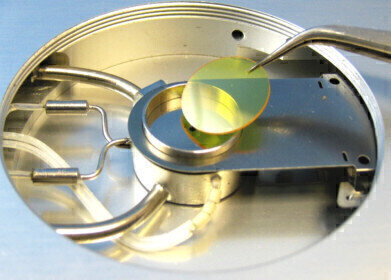Mass Spectrometry & Spectroscopy
FTIR Stage used in Combination with FTIR Spectroscopy to Visualise and Measure the In-Situ Dehydration of Silicate Materials
Oct 01 2012
At the University of Rome Tre, Professor Giancarlo Della Ventura and his colleagues are using the Linkam FTIR600 stage to look at dehydration and absorption characteristics of water in various minerals. The team has demonstrated the ability to monitor the distribution of an absorber vs. time across various samples. Dehydration curves can be obtained by collecting single-spot data in situ. The band intensity of H20/OH absorption is measured at each step during the heating process and plotted against the in situ data. Professor Della Ventura said the greatest benefit of using a Linkam stage is the "possibility to perform experiments in situ, i.e. during the thermal treatment simulation."
FTIR spectroscopy is a very powerful tool for the high-temperature studies of volatile species and can be used to obtain an infrared spectrum of the absorption of a liquid, solid or gas. This infrared collection of data can be over a wide spectral range, making FTIR an important tool in the study of minerals.
The Tre group studied the mechanism of dehydration in leucite samples from the Alban Hills and Vico volcanoes, Italy. In the first experiments, the crystal fragment was heated at 5°Cmin-1. Focal Plane Array (FPA) images were taken at 100°C intervals, using a 15x objective of the ~250x250µm2 of a 190µm thick crystal fragment. By illuminating a ~170x170µm2 area of the crystal, they were able to enhance the contrast of the water band at the edge of the crystal. During the experiment, the sample dehydrates smoothly, and at 400°C, it is almost anhydrous. In a second experiment, a second crystal is heated more quickly at 50°Cmin-1 to 300°C. When the sample reaches 300°C it has lost nearly 50% of its water. At 300°C, images were taken at intervals and show the slow dehydration and after 150 min, the sample is nearly anhydrous.
This technique has been shown to provide unique opportunities to study phenomena occurring in isotropic and anisotropic materials. The use of FTIR allows for the study of areas a few µm thick and high resolution images in a very short time provides new means to study in situ, fast dynamic phenomena under non-ambient conditions.
Digital Edition
International Labmate 49.6 - Sept 2024
September 2024
Chromatography Articles - HPLC gradient validation using non-invasive flowmeters Mass Spectrometry & Spectroscopy Articles - From R&D to QC, making NMR accessible for everyone: Putting NMR...
View all digital editions
Events
Oct 30 2024 Birmingham, UK
Oct 30 2024 Manchester, UK
Nov 11 2024 Dusseldorf, Germany
Nov 12 2024 Cologne, Germany
Nov 12 2024 Tel Aviv, Israel



















